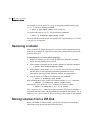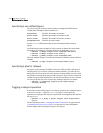
292 Administering volumes
Enabling FastResync on a volume
Enabling FastResync on a volume
Note: The recommended method for enabling FastResync on a volume with a
version 20 DCO is to use the
vxsnap prepare command as described in
“Preparing a volume for DRL and instant snapshots” on page 275.
You need a Veritas FlashSnap
TM
or FastResync license to use this feature.
FastResync performs quick and efficient resynchronization of stale mirrors. It
also increases the efficiency of the VxVM snapshot mechanism when used with
operations such as backup and decision support. See “Administering volume
snapshots” on page 303 and “FastResync” on page 66 for more information.
There are two possible versions of FastResync that can be enabled on a volume:
■ Persistent FastResync holds copies of the FastResync maps on disk. These
can be used for the speedy recovery of mirrored volumes if a system is
rebooted. This form of FastResync requires that either a version 0 or a
version 20 data change object (DCO) and DCO volume first be associated
with the volume.
See “Adding a version 0 DCO and DCO volume” on page 356, and “Preparing
a volume for DRL and instant snapshots” on page 275 for more information
on version 0 and version 20 DCO volumes respectively.
If the existing volume was created in a previous release of VxVM, and it has
any attached snapshot plexes or it is associated with any snapshot volumes,
follow the procedure given in “Upgrading existing volumes to use version
20 DCOs” on page 279.
■ Non-Persistent FastResync holds the FastResync maps in memory. These do
not survive on a system that is rebooted.
By default, FastResync is not enabled on newly created volumes. Specify the
fastresync=on attribute to the vxassist make command if you want to enable
FastResync on a volume that you are creating.
Note: It is not possible to configure both Persistent and Non-Persistent
FastResync on a volume. Persistent FastResync is used if a DCO is associated
with the volume. Otherwise, Non-Persistent FastResync is used.
To turn FastResync on for an existing volume, specify
fastresync=on to the
vxvol command as shown here:
# vxvol [-g diskgroup] set fastresync=on volume


















